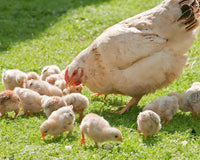So, after careful evaluation, you have decided to start raising your own flock. But how to get started? Many beginners rush to purchase chicks without a proper plan or equipment. More often, this story will not end well. Here are some essentials you will need to successfully raise healthy and thriving chickens.
If you are still undecided on raising backyard chickens, be sure to check out our helpful article, Everything You Should Know Before Starting.
Brooder
Sometimes referred as brooding box, a brooder is a box or bin to protect your baby chicks before they are ready to move into their coop. Unless you intend to start with full-grown chicken, you will need a brooder to keep your chicks warm and protected for several weeks of their life.
Big cardboard boxes or plywood boxes are good places to start with but there are some important elements of a brooder that you need to keep in mind:
- Space:
Each chick will need around 2-3 square feet to be comfortable for the first six weeks. Less space will introduce stress and negatively impact their health. Avoid square corners to prevent chicks being trapped when they huddle in one area.
- Protection:
Baby chicks are very vulnerable so keep brooder in a protected area away from any predators. Do not forget cats and dogs are also predators by nature. They cannot have any access to your brooder no matter their temperament. Basements or garages can be good places to keep your brooder.
- Warmth:
Brooders must be warm and draft-free. Cold drafts can kill baby chicks quicker than you think. Heating lamps are recommended as a heat source. An electric radiant-heat brooder will be a nice investment if you plan to raise multiple batches of chicks. Start at 95oF and reduce the temperature by 5o F each week to minimum 55oF, or until you reach the ambient temperature. However, keep in mind, you may need to observe their behavior and use your own judgement.

From left to right: Too cold, Too hot, Just right.
- Bedding:
Chicks need bedding material on their floor to keep the brooder clean and prevent slip and fall injuries. Bedding options include straw, pine shavings or corn cob bedding. Lay some paper towels underneath the bedding for grip if you have a slippery brooder floor. Do not use newspaper as it does not absorb much moisture and gets wet easily.
- Feeder and waterer:
You will need a small feeder and a waterer to keep your chicks fed and hydrated. You can find plenty of options in farm stores and on Amazon. It is recommended to use feeders with hole-openings instead of wide-opening to prevent chicks from getting into the feeding pen which they will then contaminated with dirt and poop.

- Cleanliness:
Chicks are very messy. They play with feed and water, kick a lot of dust and bedding, and poop everywhere. It is important to remove poop and wet bedding daily as the warmth and moisture creates the perfect environment for bacteria growth. Remember to check the feeder frequently for any fecal contaminants and change feed when necessary. Likewise the waterer needs to be changed daily.
Coop
Brooders are for chicks while coops are for full-grown chicken. Unlike a brooder which is usually placed indoor, coops are almost always placed in your backyard.
In many ways a is coop simply a bigger version of a brooder. Both provide a safe and efficient shelter for backyard chicken flocks.
There are many ready-to-build coop kits that you can purchase, but here we’ve outlined how to determine which one is right for you:
- Space:
It is recommended to have at least 3 square feet of coop space and 8 to 10 square feet of outdoor space for a mid-sized bird. Going lower than this would create overcrowding for your chickens. This will not only affect chicken health but will also induce serious pecking behavior, which causes severe injuries and sometimes death.
- Protection:
Moving from indoor to outdoor means the coop needs to be weather and predator proof. Proper shelter and heating helps to combat heavy rain and low temperature. Take care of all cracks and seams in your yard fencing. Predators like snakes, foxes, rats, weasels, and raccoons will find a way to your chickens and the results will be tragic and heartbreaking.
- Ventilation:
A coop should have good ventilation and a heat source so it can be cool in the summer and warm in the winter. Sufficient ventilation is crucial for low moisture, optimal temperature, and good air quality. High ammonia is the top 1 reason for respiratory problems. Add more ventilation holes if you think it is too hot or smells are getting too strong in the coop. Mixing yucca into feed and bedding can help if the ammonia gets particularly bad.
- Roosts:
Roosts are a resting and sleeping area raised from the floor. Chicken sleep up off the ground by nature to avoid their predators. Wild chickens for example sleep on trees. Roosts should be higher than the nesting box. Building with 2”x4” lumbers is the most common DIY option; however, tree branches and wooden ladders can work if their little feet can wrap on and they have enough space to sit. Do not use materials like metal or PVC as they are too slippery and there is no fun in falling down while asleep. 
- Nesting box:
The nesting box is the sole location your chickens will lay eggs. They should be clean, quiet, dark, and lower than the roost bars. Bedding material must be dry and soft such as wood shavings or chopped straw. It is recommended to have one nesting box for every 4-5 chickens. You can have more so your chickens can have options when some occupied but no less. You can purchase nesting boxes from most farm stores.

- Feeder and waterer:
Similar to the ones for your baby chicks but of course bigger. You will need at least 4 inches of feeder space for every chicken and a sufficient clean water source so all your chickens can have easy access to feed and water. Gravity feeders are the most common option. They are simple yet effective. Since there are fairly cheap, it is probably a good idea to buy several to prevent a dominant hen blocking other’s access to feed. There are automated feeders out there but it’s more of a high-end luxury equipment.
- Bedding:
A coop is not ready until it has bedding material. Simply cover the floor with wood shave, dry leaves, or straw, and remember to put extra in the nesting box to make it soft and cozy. Bedding material help to absorb moisture and keep their feet protected. Change the bedding when it starts to smell bad.
There you have it, the necessities for a successful start to raising backyard chickens. It may seem complicated for beginners, but it gets very straight forward once you get the hang of it. Chickens are not very needy; they just require a clean and safe place to settle down. Once you set proper housing following our tips with feed and water you will be on your way to raising happy home chicks.
For more information on backyard chicken supplies, check our Green Star supply section for poultry products.






